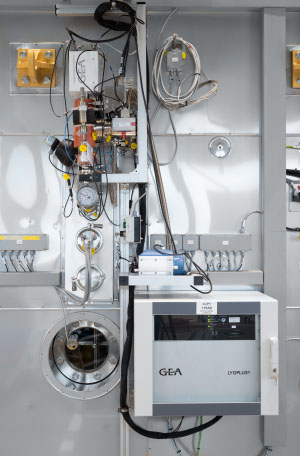A lot of the revised content is new to Annex 1 — the European Commission’s revised good manufacturing practice (GMP) guidelines — but not new to GEA, says Jessica Wagner, Validation Engineer.
To cite an example, a new requirement from Annex 1 is that users must be able to detect any leaks “that would present a risk to the product.” Here, of course, GEA recommends LYOPLUS®.
This multipurpose measuring device (mass spectrometer) has been designed to detect different kinds of silicone oil and hydraulic fluids. It can also monitor the moisture content in the freeze-drying chamber during the drying cycle and reduce leak detection times down to just one hour.
Similarly, the company’s ALUS® Automatic Loading and Unloading Systems minimize the risk of contamination by reducing human intervention, which comes with the added benefits of decreasing processing times, improving productivity and, by using cutting-edge monitoring systems, reducing operational costs.
Plus, anticipating the future rise of automated systems, GEA has already taken a significant step forward. The introduction of the ALUS Robot aligns with the industry’s commitment to increasing product protection and eliminating direct operator interventions.

Robotic automation ensures error-free product handling by utilising nests to prevent container fall, minimise glass-on-glass contact and increase processing speeds to up to 1000 vials per minute in larger systems.
GEA is also ensuring future compliance by providing relevant Contamination Control Strategy (CCS) documents, including CFD studies, GMP risk analysis and rationale-based monitoring concepts.
Current best practice is now defined in Annex 1, she adds, but GEA was already working to these high standards to meet industry requirements. Perhaps the only real changes that were made involved adding a second temperature sensor and the option to install a remote camera if required (to permit observation of production activities from outside grade A and B areas).
Annex 1 states that “freeze-drying systems should be monitored for temperature, pressure and time at appropriate locations during routine use to ensure that all areas are effectively and reproducibly sterilised. These locations should be demonstrated as being representative of, and correlated with, the slowest to heat locations during initial and routine validation.”
This is now a default setting for GEA machines and the updates were relatively minor. As a final word, Jessica asserts that GEA freezer dryers are fully compliant with Annex 1 and that older machines — if not already — can be retrofitted to make them compatible.
In summary, notes Jessica, whatever the requirements of Annex 1, whether new or updated, GEA has a solution. We’ve already implemented a remote camera in several projects, we’ve added sterilise-in-place (SIP) safeguards and we’re spending a lot of time working on robotic applications to develop and improve the existing technology. This is not just because of Annex 1, it’s to ensure that we’re serving our customers in the best possible way.
Our team can also update third-party equipment to bring your entire setup in line with the new regulations,” she adds: “Don’t hesitate to contact us for a full assessment of your current needs or future requirements. Finally, we’d advocate not waiting until the last minute when the legislation comes into force in August 2024. Act now to ensure you’re ready.





